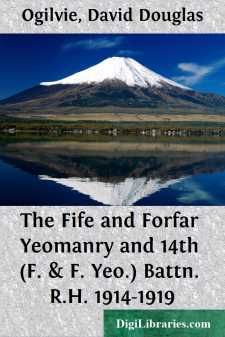Categories
- Antiques & Collectibles 13
- Architecture 36
- Art 48
- Bibles 22
- Biography & Autobiography 813
- Body, Mind & Spirit 142
- Business & Economics 28
- Children's Books 17
- Children's Fiction 14
- Computers 4
- Cooking 94
- Crafts & Hobbies 4
- Drama 346
- Education 46
- Family & Relationships 57
- Fiction 11829
- Games 19
- Gardening 17
- Health & Fitness 34
- History 1377
- House & Home 1
- Humor 147
- Juvenile Fiction 1873
- Juvenile Nonfiction 202
- Language Arts & Disciplines 88
- Law 16
- Literary Collections 686
- Literary Criticism 179
- Mathematics 13
- Medical 41
- Music 40
- Nature 179
- Non-Classifiable 1768
- Performing Arts 7
- Periodicals 1453
- Philosophy 64
- Photography 2
- Poetry 896
- Political Science 203
- Psychology 42
- Reference 154
- Religion 513
- Science 126
- Self-Help 84
- Social Science 81
- Sports & Recreation 34
- Study Aids 3
- Technology & Engineering 59
- Transportation 23
- Travel 463
- True Crime 29
The Fife and Forfar Yeomanry and 14th (F. & F. Yeo.) Battn. R.H. 1914-1919
Description:
Excerpt
CHAPTER I
AT HOME—1914-1915
August 4th, 1914, marks the end and also the beginning of two great epochs in the history of every Territorial Unit. It marked the close of our peace training and the beginning of thirteen months' strenuous war training for the thirty-seven months which we were to spend on active service abroad.
The Fiery Cross which blazed across the entire Continent caught most people unawares and unprepared—but not so our headquarters. Our mobilization papers had already been made out and were despatched immediately on the outbreak of war. Each one of us was bidden to report forthwith to his Squadron Headquarters, and while we kicked our heels there, officers were scouring the country for horses. Soon these came in of every sort and shape, and in a week's time the Regiment was concentrated at Blairgowrie.
The headquarters of the Regiment was at Kirkcaldy, the four Squadrons A, B, C, and D having their headquarters respectively at Cupar, Dunfermline, Dundee, and Forfar. The recruiting area comprised the counties of Fife, Forfar, Kinross, and Clackmannan, and there was also a troop in Stirlingshire within a few miles of Loch Lomond. The rest of the Highland Mounted Brigade, to which the Regiment belonged, was pure Highland, consisting of two regiments of Lovat's Scouts, the Inverness Battery, R.H.A., and a T. and S. Column and Field Ambulance hailing also from Inverness. On changing to War Establishment, D Squadron dropped out and was divided amongst A, B, and C, with the exception of Lieut.-Colonel King who went to Remounts, and Captain Jackson who became Staff Captain on the newly formed Brigade Staff.
The Regiment was fortunate in having about a week at Squadron Mobilization Centres before uniting at Blairgowrie, and a pretty hectic week it was for most of us. The most rapid bit of work must have been that of D Squadron, whose men were distributed amongst the other squadrons, fully equipped, in about three days. This squadron was also called upon to provide the various details, such as mounted police, who were required on mobilization to report to the Highland Territorial Infantry Division, the famous 51st.
N.C.O.'s AT FAKENHAM, 1915.
Back Row (left to right).—Sgts. Edmond, Petrie, Annand, M'Niven. Second Row.—Farr.-Sgt. Lindsay, Sgts. Inglis, Gourlay, Farr.-Sgt. Renton, Sgt. Abbie, Saddler-Sgt. Smith, Sergt. Kirk, F.Q.M.S. Allan, Sgts. Hood, Walker, Colthart, Haig, Lumsden, Thorp, Dougall, Couper, Bradfield, Craig. Third Row.—Sgts. Thornton, Aitken, S.Q.M.S. Craig, S.S.M. Edie, S.S.M. Ogilvie, Capt. and Adjt. M.E. Lindsay, R.S.M. R.G. Rapkin, Capt. Jackson, S.S.M. M'Laren, S.S.M. Adams, S.Q.M.S. W. Birrell, Farr.-Sgt. W. Guthrie, Sgt. J. Wilson. Front Row.—Sgts. Scott, Stewart, Gair, Duff, Hair, Adams, Kidd, and Henderson.
To face page 2
During this first week squadrons had to arrange for their own billeting, forage, and rations; take over, shoe, brand, and number the horses as they were sent up in twos and threes by the buyers; mark all articles of equipment with the man's regimental number; fit saddlery; see that all ranks had brought with them and were in possession of the prescribed underclothing, boots, and necessaries; take on charge all articles on the Mobilization Store Table as they arrived in odd lots from Stirling; and, beyond the above duties, which were all according to regulation, to make unofficial arrangements to beg, borrow, or steal clothing of sorts to cover those who had enlisted, or re-enlisted, to complete to War Establishment, and to provide for deficiencies in the saddlery and clothing already on charge....


